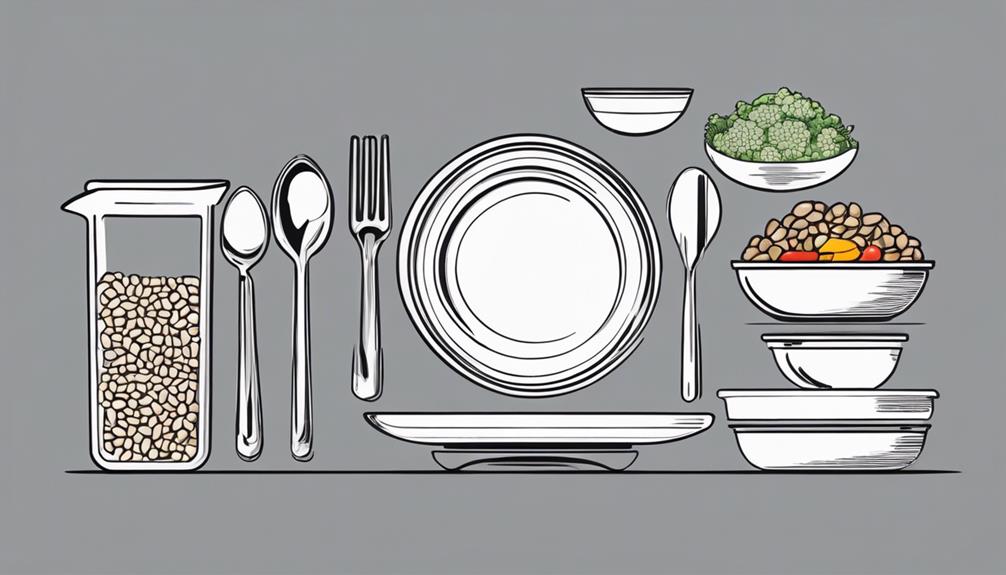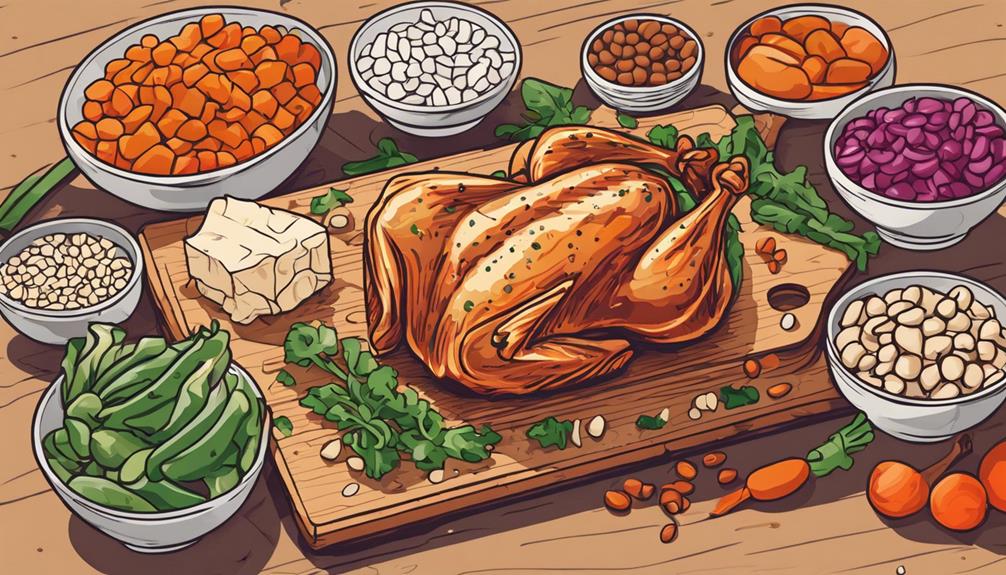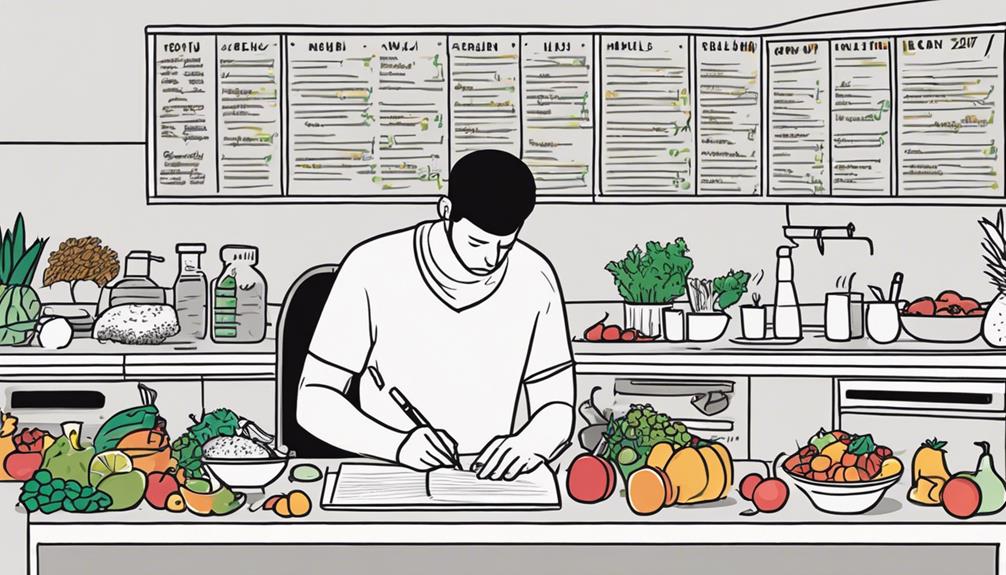When managing diabetes, you may feel overwhelmed by the idea of meal planning. However, incorporating simple tactics into your routine can make a significant difference in your health.
From portion control to strategic ingredient choices, these meal planning strategies can help you maintain stable blood sugar levels throughout the day.
By implementing these tactics, you can take charge of your diabetes management and enjoy a balanced approach to your meals.
Key Takeaways
- Master portion control with plate visualization for stable blood sugar levels.
- Focus on fiber-rich foods to aid in blood sugar control and weight management.
- Include lean proteins and healthy fats in balanced meals for better glucose regulation.
- Limit added sugars and refined carbs by choosing whole foods and reading labels carefully.
Importance of Portion Control

To effectively manage your diabetes, mastering portion control is crucial in maintaining stable blood sugar levels throughout the day. Plate visualization and measuring your food can be powerful tools in achieving this. Visualize your plate divided into sections: half filled with non-starchy vegetables, a quarter with lean protein, and a quarter with whole grains or starchy vegetables. This balanced meal ratio can help you control your portions and keep your blood sugar levels in check.
Mindful eating is also key when it comes to portion control. Slow down and pay attention to your hunger cues. Avoid distractions while eating, such as watching TV or working, as this can lead to overeating. By focusing on your meal, you can better gauge when you're full and avoid consuming excess calories.
Focus on Fiber-Rich Foods
Incorporate fiber-rich foods into your daily meals to enhance your overall health and diabetes management. Fiber benefits individuals with diabetes by helping to control blood sugar levels, lower cholesterol, and promote a healthy weight. Soluble fiber, found in foods like oats, beans, and fruits, can slow down digestion and the absorption of sugar, leading to more stable blood glucose levels.
Insoluble fiber, present in vegetables, whole grains, and nuts, aids in digestion and helps prevent constipation, a common issue for people with diabetes.
When planning your meals, consider incorporating fiber-rich options such as chia seed pudding for breakfast, a quinoa and black bean salad for lunch, and a dinner consisting of grilled salmon with a side of roasted vegetables. Snack on almonds, carrots with hummus, or a piece of fruit throughout the day to increase your fiber intake. These meal ideas not only provide essential nutrients but also contribute to better blood sugar control and overall well-being for individuals managing diabetes.
Incorporate Lean Proteins

Enhance your diabetic meal plan by prioritizing lean proteins that can support your health and well-being. Lean proteins are essential for diabetics as they provide necessary nutrients without excess saturated fats. Opt for sources like skinless poultry, fish, tofu, legumes, and lean cuts of meat. These proteins can help regulate blood sugar levels and contribute to overall better health outcomes.
When incorporating lean proteins into your meals, focus on preparing them in healthy ways. Grilling, baking, steaming, or sautéing with minimal oil can help retain their nutritional value. Additionally, consider pairing lean proteins with vegetables and whole grains to create balanced meals that provide sustained energy and promote satiety. This combination can also help prevent spikes in blood sugar levels while offering a variety of essential nutrients.
Remember to include healthy fats in your meal planning as they play a crucial role in supporting cell function and providing energy. Nuts, seeds, avocados, and olive oil are excellent sources of healthy fats that can complement your lean protein choices and contribute to well-rounded, balanced meals.
Limit Added Sugars and Refined Carbs
Consider prioritizing whole foods and fresh ingredients to limit added sugars and refined carbs in your diabetic meal plan. Opt for sugar substitutes like stevia or monk fruit to sweeten your dishes without causing blood sugar spikes.
When choosing carb alternatives, focus on whole grains like quinoa, barley, or buckwheat instead of refined grains like white rice or pasta. These whole grains provide more fiber and nutrients, which can help manage blood sugar levels more effectively.
Reading food labels can also be crucial in identifying hidden sugars and refined carbs in packaged foods. Look out for ingredients like high-fructose corn syrup, maltose, or white flour, as these can significantly impact your blood sugar.
Opting for homemade meals allows you to have more control over the ingredients you use, helping you reduce added sugars and refined carbs in your diet.
Plan Ahead for Success

To set yourself up for success in managing your diabetes through meal planning, establish a weekly schedule for meal preparation and grocery shopping. Planning ahead ensures that you have the right foods on hand, making it easier to stick to your dietary requirements.
Begin by creating a meal plan for the week, taking into account your nutritional needs and preferences. Once your meals are planned, make a detailed grocery list to avoid impulse buys and ensure you have all the necessary ingredients.
Efficient grocery shopping is key; try to shop at times when the store is less crowded to save time. Consider utilizing grocery delivery services or curbside pickup options to streamline the process further.
When you return from shopping, take the time to prep some ingredients in advance, such as washing and chopping vegetables. This simple step can save valuable time during the week and make meal preparation a breeze.
Effective time management and organization are crucial for maintaining a healthy diet while managing diabetes.
Frequently Asked Questions
Can Diabetics Still Enjoy Their Favorite Foods in Moderation While Following a Meal Plan?
You can still enjoy your favorite foods in moderation with proper portion control. Indulge smartly by balancing your meal plan. With mindfulness and balance, you can savor your favorites while managing your diabetes effectively.
Are There Any Specific Cooking Techniques That Can Help Retain Nutrients in the Food for Diabetics?
To retain nutrients in your food, try steaming, roasting, or grilling. These cooking techniques can help preserve the vitamins and minerals in your meals. Experiment with different methods to find what works best for you.
How Can Diabetics Ensure They Are Getting a Balanced Mix of Nutrients in Their Meals?
To ensure balanced nutrients, remember, like a painter with a palette, portion control is key. Choose smart snack options, time nutrients wisely, and swap foods wisely. With these tactics, you can create meals that fuel you well.
Are There Any Specific Meal Planning Apps or Tools That Can Help Diabetics Stay on Track?
To stay on track, consider using meal planning apps and nutrition tracking tools. These resources can help simplify your journey towards better health by providing guidance, organization, and insight into your dietary choices.
How Can Diabetics Adjust Their Meal Plan When Eating Out at Restaurants or Social Gatherings?
When dining out or at social events, remember to prioritize smart eating strategies. Choose grilled or steamed dishes, opt for veggies as sides, watch portion sizes, and limit sugary drinks. Don't forget to enjoy yourself!
Conclusion
In conclusion, by implementing these simple meal planning tactics for diabetics, you're laying the foundation for a healthier and more balanced lifestyle.
Just like a well-organized pantry creates ease and efficiency in the kitchen, planning your meals in advance sets you up for success in managing your diabetes.
With portion control, fiber-rich foods, lean proteins, and mindful choices, you're building a solid structure for optimal health and well-being.
So, take control of your health and start meal planning today!